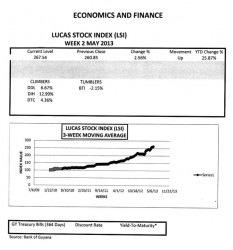Swirling Around
The economy of Guyana exhibited significant vibrancy last year in many ways. One of the ways was through the expansion of credit to the private sector. Not only did net domestic credit by the banking system increase by 10.6 percent, the output of the financial and insurance sector itself grew by 13.8 percent. From the numbers cited in the 2013 budget speech, there is clearly much money swirling around Guyana. The data from the Bank of Guyana support the view that bank lending has gone up significantly over the last three years, having grown at an average of 21 percent during that time, outpacing the growth rate of deposits by about six percentage points. The expansion of the financial sector also came with expanded income for the banks and other entities operating in that industry. For the last three years, the income accruing to the sector went up by an average of 13 percent each year. The credit expansion reflects the financial flows model that there is a basic relationship between bank loans and bank deposits. But banks are facing a liquidity overhang that might also be connected to the portfolio model stemming from the structural change in the financial market that occurred in 2003 with the introduction of the Guyana Stock Exchange.
Critical Ratio
The primary base from which banks make loans is the deposits that they receive from depositors. Recent developments in the financial sector in Guyana reveal that banks, in general, remain conservative in the management of the money that they handle for their customers. Deposits grew by 15 percent last year and by 10 percent in 2011, maintaining a trend of positive growth observed since 2001.

The Lucas Stock Index (LSI) rose 2.56 percent during the second week of trading in May 2013. A total of 89,770 stocks of seven companies changed hands. Leading the Climbers was Banks DIH (DIH) which traded 28,420 shares with a 12.99 percent increase in value. Demerara Distillers Limited (DDL) also recorded a gain of 6.67 percent after trading 2,334 shares. Demerara Tobacco Company (DTC) gave up 366 shares and increased 4.36 percent in value. The only Tumbler this week was Guyana Bank for Trade and Industry (BTI) which fell 2.15 percent on the sale of 2,100 shares. Demerara Bank Limited (DBL), Caribbean Container Incorporated (CCI) and Republic Bank Limited (RBL) traded 32,300; 22,100 and 2,150 shares respectively for no gain.
Despite the growth in deposits, and the recently observed expansion in bank credit, a critical ratio, the loan-to-deposit ratio (LTD), remains relatively low. Within the last 10 years, the LTD ratio has been stuck in the range of 29 to 37 percent based on the annual data released by the BOG. In the prior years of 2001 and 2002, the LTD ratio was as high as 55 and 48 percent respectively. A low LTD ratio means that banks are not having a difficult time gaining access to resources. Indeed, deposits have exhibited an annual growth rate of 12 percent within the last 10 years while bank lending lagged behind, growing at an average of nine percent over the same period. What this trend indicates is banks have been having a hard time finding lucrative investment opportunities.
Glimpse of Attitude
The situation facing individual banks varies. Year-on-year quarterly data from the BOG provide a glimpse of the attitude and strategic thinking of banks towards lending. In 2010, while the industry average of business loans to total loans was 49 percent, four of the six banks exceeded that figure. Demerara Bank Limited (DBL) had the highest share at 79 percent of its loan portfolio. Guyana Bank for Trade and Industry (BTI) had 75 of its loan assets in business investments while the Bank of Baroda (BOB) had 72 percent of its assets in the business sector. With a comparatively smaller share of 54 percent, Citizens Bank (CBI) also preferred to lend to the business community. It was only Republic Bank and Scotiabank that were under the industry average with 45 and 21 percent respectively. By the last quarter of 2012, the BOB had established that it was hanging its hat on the local business community. It had over 96 percent of its loan balances with the business sector while its competitors kept a stable portfolio from 2010 through 2012.
Overall Distribution
The overall distribution of the loan assets of the commercial banks is evidence of the strategic focus of each institution. Four of the banks (BOB, BTI, DBL and CBI) have a greater orientation towards the business community while two seem to pursue a more balanced strategy. The BOB has clearly staked its fortunes in the business prospects of Guyana with 88 percent of its loan balances for the last three end-of-year quarters held by the business community. BTI has 76 percent of its loans with the business community, DBL has 75 percent and CBI has 58 percent of its loans in the private sector. RBL and BNS, which also have majority foreign ownership like the BOB, reflect a more balanced strategy. They are the principal lenders to households even though they too have a larger share of their loan assets with the business sector.
The relationship between business and household is not as skewed for RBL and BNS as it is for the other four. The heavy emphasis on loans to the business sector would suggest that the ratio of commercial loans to household loans would be very high, especially during this period of economic expansion. Yet, the ratio of commercial loans to household loans is lower in the last five years than they were in the period 2003 to 2007. The ratio was 2.79 percent from 2003 to 2007 as against 2.39 from 2008 to 2012.
Liquidity Overhang
One has to wonder if the low LTD ratio alone explains the liquidity overhang of the commercial banks. The portfolio model suggests that, with the introduction of the Guyana Stock Exchange in 2003, banks do not rely solely on deposits to fund their investments. They can raise money for investment purposes through the sale of stocks. The availability of this option, reflected in the market capitalization of the four banks participating in the stock market, could be contributing to the expansion in lending without having to depend on deposits. From 2003 to 2012, deposits have grown 180 percent.
That is a sizable increase in deposits that become available for lending. However, over the same period, the four commercial banks that are part of the Lucas Stock Index (LSI) grew their market capitalization by 129 percent. The expansion was greater for two of the largest banks in Guyana, RBL and BTI, whose market capitalization grew by 204 percent. In other words, the banks might have garnered more money through equity transactions than through bank deposits since 2003.
Interest Costs
The foregoing information creates the likelihood that with resource growth coming through alternative means, interest costs would have little impact on net income.
The failure of Guyanese to take advantage of the returns offered by the local stock exchange gives banks very little incentive to increase interest rates to attract deposits.
However, with the excess liquidity in the system, lending rates were falling. But in 2012, the spread was 9.73, the largest since 2006 when it was 9.93.
The cursory examination here of the implications of the stock market for bank deposits and hence lending does not reach a definitive conclusion.
Nonetheless, no one could rule out a relationship just yet and a closer examination for a correlation between portfolio investing and bank lending might be a useful exercise.






